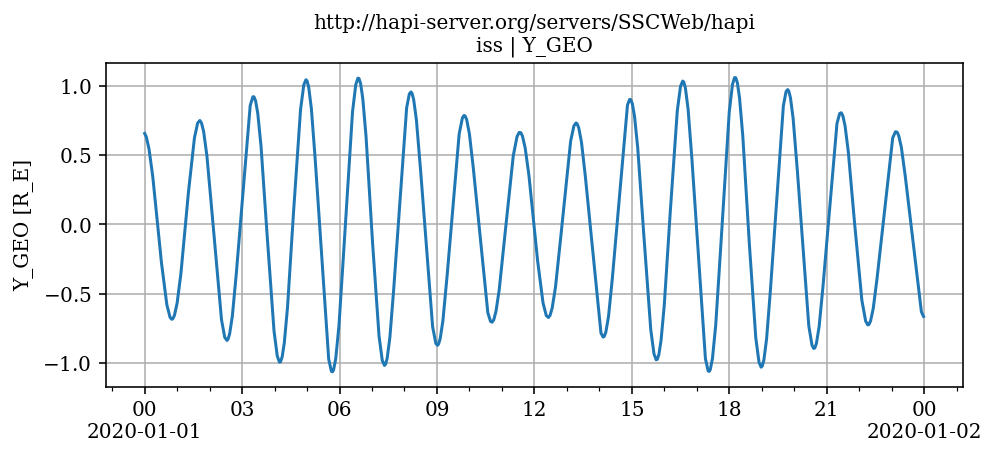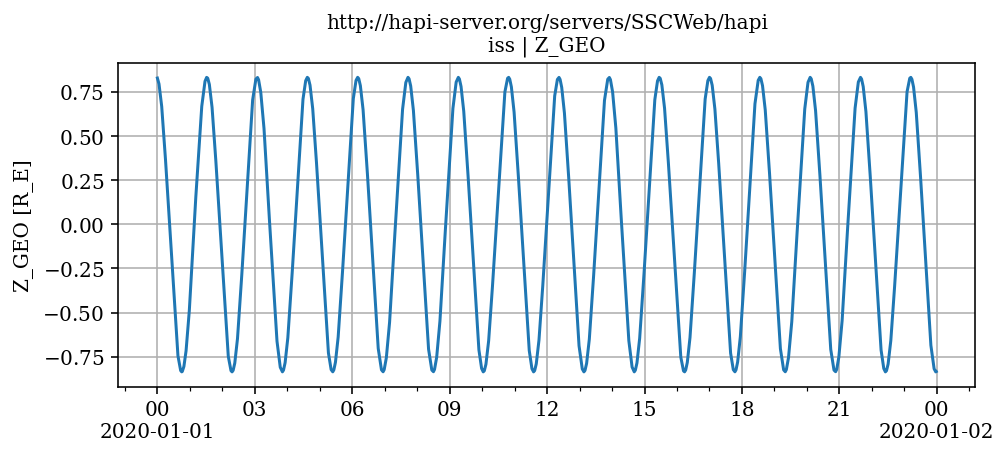External Data Sources#
Abstract: Here we show short introductions to Python packages that provide access to various other data sources.
%load_ext watermark
%watermark -i -v -p hapiclient
Python implementation: CPython
Python version : 3.11.6
IPython version : 8.18.0
hapiclient: 0.2.6
HAPI (hapiclient)#
The Heliophysics Data Application Programmer’s Interface (HAPI) specification provides a common framework being adopted by many data providers across heliophysics. The aim is to ease sharing of data between different services and support an interoperable ecosystem. All components are developed openly on GitHub where you will find client software in various languages (MATLAB, Java, IDL etc.) to access data from HAPI servers. In this section we demonstrate how to use the Python package, hapiclient, that provides very similar functionality to viresclient. For more examples, see here.
To discover what servers and data are out there, try the HAPI server browser. This lets you browse the catalogs and generate preview images of data as well as the Python script necessary to access the data yourself.
Here is an example of accessing the position of the ISS using the HAPI server provided by NASA’s Satellite Situation Center service (SSCWeb):
from hapiclient import hapi
server = 'http://hapi-server.org/servers/SSCWeb/hapi';
dataset = 'iss';
# Use parameters='' to request all data. Multiple parameters
# can be requested using a comma-separated list, e.g., parameters='X_TOD,Y_TOD'
parameters = 'X_GEO,Y_GEO,Z_GEO';
start = '2020-01-01T00:00:00.00';
stop = '2020-01-02T00:00:00.00';
data, meta = hapi(server, dataset, parameters, start, stop)
Data are automatically loaded as a NumPy structured array and metadata as a dictionary:
data
array([(b'2020-001T00:00:00Z', -0.11105764, 0.65621122, 0.8300275 ),
(b'2020-001T00:01:00Z', -0.17963564, 0.65040395, 0.82257963),
(b'2020-001T00:02:00Z', -0.24745595, 0.64222876, 0.81135568),
...,
(b'2020-001T23:57:00Z', -0.12685546, -0.65262311, -0.83431709),
(b'2020-001T23:58:00Z', -0.05823442, -0.65973535, -0.83633816),
(b'2020-001T23:59:00Z', 0.01059807, -0.66446651, -0.83455147)],
dtype=[('Time', 'S18'), ('X_GEO', '<f8'), ('Y_GEO', '<f8'), ('Z_GEO', '<f8')])
meta
{'startDate': '1998-11-21T00:00:00.000Z',
'stopDate': '2026-01-04T00:00:00.000Z',
'cadence': 'PT60S',
'description': 'ISS ephemeris',
'resourceURL': 'https://sscweb.gsfc.nasa.gov/',
'parameters': [{'name': 'Time',
'type': 'isotime',
'units': 'UTC',
'fill': None,
'length': 18},
{'name': 'X_GEO',
'description': 'X Position in the Geographic coordinate system, also known as Greenwich Rotating Coordinates GRC, or Earth-fixed Greenwich EFG',
'units': 'R_E',
'fill': '1e31',
'type': 'double'},
{'name': 'Y_GEO',
'description': 'Y Position in the Geographic coordinate system, also known as Greenwich Rotating Coordinates GRC, or Earth-fixed Greenwich EFG',
'units': 'R_E',
'fill': '1e31',
'type': 'double'},
{'name': 'Z_GEO',
'description': 'Z Position in the Geographic coordinate system, also known as Greenwich Rotating Coordinates GRC, or Earth-fixed Greenwich EFG',
'units': 'R_E',
'fill': '1e31',
'type': 'double'}],
'HAPI': '2.0',
'status': {'code': 1200, 'message': 'OK'},
'x_server': 'http://hapi-server.org/servers/SSCWeb/hapi',
'x_dataset': 'iss',
'x_parameters': 'X_GEO,Y_GEO,Z_GEO',
'x_time.min': '2020-01-01T00:00:00.00Z',
'x_time.max': '2020-01-02T00:00:00.00Z',
'x_requestDate': '2025-12-21T11:10:53',
'x_cacheDir': '/tmp/hapi-data/hapi-server.org_servers_SSCWeb_hapi',
'x_downloadTime': 2.540121078491211,
'x_readTime': 0.0001933574676513672,
'x_metaFileParsed': '/tmp/hapi-data/hapi-server.org_servers_SSCWeb_hapi/iss___.pkl',
'x_dataFileParsed': '/tmp/hapi-data/hapi-server.org_servers_SSCWeb_hapi/iss_X_GEO,Y_GEO,Z_GEO_20200101T00000000_20200102T00000000.npy',
'x_metaFile': '/tmp/hapi-data/hapi-server.org_servers_SSCWeb_hapi/iss___.json',
'x_dataFile': '/tmp/hapi-data/hapi-server.org_servers_SSCWeb_hapi/iss_X_GEO,Y_GEO,Z_GEO_20200101T00000000_20200102T00000000.bin',
'x_totalTime': 3.0173499584198}
hapiclient also provides tools for intelligent automatic plotting of data with the hapiplot package. hapiplot is currently not installed but we can patch it in on-the-fly and use it:
%pip install "git+https://github.com/hapi-server/plot-python@f95ce860d456dd9278a62897d6f83d416c988273" --quiet
from hapiplot import hapiplot
WARNING: Running pip as the 'root' user can result in broken permissions and conflicting behaviour with the system package manager, possibly rendering your system unusable. It is recommended to use a virtual environment instead: https://pip.pypa.io/warnings/venv. Use the --root-user-action option if you know what you are doing and want to suppress this warning.
Note: you may need to restart the kernel to use updated packages.
(NB: We are using a more recent development version of hapiplot, rather than what is on PyPI)
hapiplot(data, meta);



